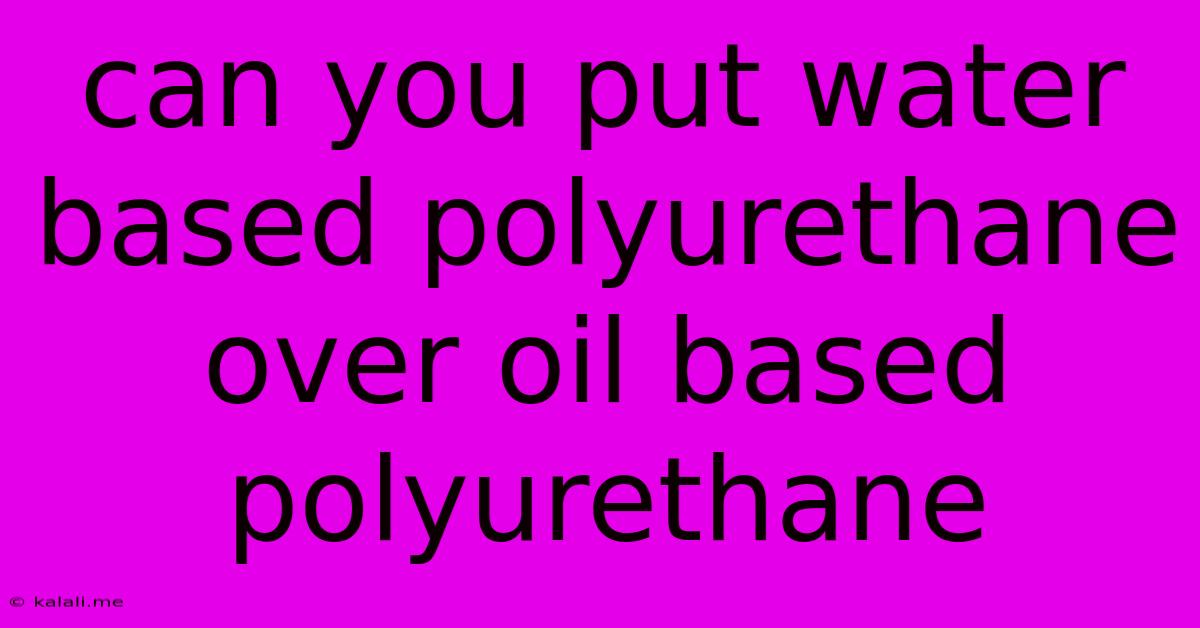Can You Put Water Based Polyurethane Over Oil Based Polyurethane
Kalali
May 24, 2025 · 3 min read

Table of Contents
Can You Put Water-Based Polyurethane Over Oil-Based Polyurethane? The Definitive Guide
This question pops up frequently among DIY enthusiasts: Can you apply water-based polyurethane over oil-based polyurethane? The short answer is generally no, and attempting to do so can lead to several problems. This article will delve into the reasons why, explore the potential consequences, and offer solutions for achieving the desired finish.
Why You Shouldn't Layer Water-Based Over Oil-Based Polyurethane
Oil-based and water-based polyurethanes have fundamentally different chemical compositions. Oil-based polyurethane is, as the name suggests, oil-based and cures through oxidation. Water-based polyurethane, on the other hand, is water-based and cures through evaporation of water and polymerization of the resin. This difference leads to several compatibility issues:
-
Poor Adhesion: The biggest problem is poor adhesion. Water-based polyurethane struggles to bond properly with the oily surface of cured oil-based polyurethane. This leads to peeling, chipping, and an overall unsatisfactory finish. The water in the water-based poly may even cause the oil-based layer to lift or become tacky.
-
Yellowing: Oil-based polyurethanes are more prone to yellowing over time, especially when exposed to UV light. While modern formulations have improved, this yellowing could be amplified when layered under a clear water-based coat, making the yellowing more apparent.
-
Reactions: While not always guaranteed, there's a chance of chemical reactions between the two types of polyurethane. This could result in a cloudy finish, bubbling, or other undesirable effects on the surface. The curing process might also be affected, leading to a weaker or less durable finish.
-
Cleaning: The cleanup process for oil-based and water-based polyurethanes differs significantly. Mixing them up can lead to complications and inefficiencies during cleanup.
What Happens If You Do It Anyway?
Ignoring the compatibility issues and applying water-based polyurethane over oil-based polyurethane will likely result in a subpar finish. You might experience:
- Peeling or flaking: The new coat won't adhere properly, leading to significant peeling or flaking over time.
- Bubbling or blistering: The water in the water-based polyurethane may react with the oil-based layer, causing bubbling or blistering.
- An uneven finish: The new coat may not spread evenly, leading to an uneven or blotchy look.
- A shorter lifespan: The final finish will be less durable and won’t last as long as a properly applied finish.
Alternative Solutions for Achieving the Desired Finish
Instead of layering water-based over oil-based polyurethane, consider these alternatives:
-
Sand and reapply oil-based polyurethane: If you already have an oil-based layer, the best approach is often to thoroughly sand it down to create a good surface for a fresh coat of oil-based polyurethane. This will ensure proper adhesion and a long-lasting finish. Use fine grit sandpaper (like 220-grit) and remove any dust before applying a new coat.
-
Start fresh with water-based polyurethane: If you're starting from scratch, using only water-based polyurethane offers a more straightforward and reliable approach. This ensures compatibility and eliminates the risk of issues arising from mixing different types.
In Conclusion
While it might seem tempting to layer water-based polyurethane over oil-based polyurethane to save time and effort, it's generally not recommended. The incompatibility between these two types of polyurethane can lead to a variety of problems, ultimately resulting in a subpar and short-lived finish. Always opt for a compatible approach, either sanding and reapplying oil-based polyurethane or starting with a fresh coat of water-based polyurethane to achieve a smooth, durable, and aesthetically pleasing finish. Remember to always follow the manufacturer's instructions carefully for best results.
Latest Posts
Latest Posts
-
No Rule To Make Target Compiling
May 24, 2025
-
How To Go Third Person In Minecraft
May 24, 2025
-
Can A Planeswalker Be A Commander
May 24, 2025
-
What Gauge Wire For 30 Amp
May 24, 2025
-
Mom Kept Stealing Money From Me
May 24, 2025
Related Post
Thank you for visiting our website which covers about Can You Put Water Based Polyurethane Over Oil Based Polyurethane . We hope the information provided has been useful to you. Feel free to contact us if you have any questions or need further assistance. See you next time and don't miss to bookmark.